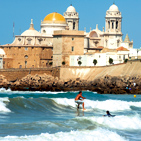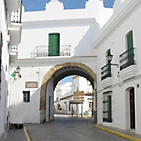Following 260 kms. of coastline, beaches are the finest golden sand of the peninsula. This route is full of scenic surprises, and even the remains of ancient civilizations such as the Roman ruins of Baelo Claudia, near Tarifa, meeting of two seas, the Atlantic and Mediterranean.

Cádiz
The capital of the province. An important Sea port. It is the oldest city in the western world, with more than 3,000 years of history. Although it was initially founded by the Phoenicians, many other cultures have left the marks of their passage, Greeks, Romans, Visigoths and Arabs. The city is essentially Andalusian, with highly characteristic areas such as “La Viña”, “Santa María” or “El Pópulo” which contrast with the modern constructions of the more recently built quarter. Plants and trees, some of which are over one thousand years old, can be found in its parks and avenues. The Bay of Cádiz and its beaches are perfect for the persuit of all water-sports and it annually host important sailin events. The Carnaval, which has a long-standing tradition, stands out as an important local celebration.

Puerto Real
Declared a Protected area of Historical/Artistic interrest Separated from the capital by the bridge over the Bay of Cádiz and founded by the Catholic Kings, it is today a lively and cultural town. Naval industry. It boasts good sports facilities and the pine forest “Parque de las Canteras” is to be found just outside the town.

San Fernando
On the Bay of Cádiz, only 10 kilometres from the capital, Cádiz. It is populary known as “La Isla” (The Island) and has a long seafaring tradition. It is famous for its salt-flats and fish farms. The layout of its streets is typically Andalusian. Its Teatro de las Cortes was transformed into a parliamentary chamber from 1810 to 1812.

Chiclana
Placed among beaches, salt-flats and pine forest. In crafts, its dolls in traditional Andalusian dress are famous. Good cake and pastry making. The island of Sancti Petri, with its XVIII century castle is just off the coast. An ideal area for windsurfing. Good beaches. “Novo Sancti Petri” Tourist Complex. Golf courses. Good hotel infrastructure.

Conil de la Frontera
Its privileged location on the coast gives this town a tradition of tourism and seafaring. Surrounded by housing estates and camping sites. Ceramics production. Magnificent beaches. Restaurants specializing in fresh fish caught daily. Ethnological Museum. Guzmán Tower (XIV-XV)

Vejer de la Frontera
A breathtakingly beautiful village set at the top of a steep hill, it is a perfect example of Arab/Andalusian architecture. It is declared a Protected Area of Historical/Artistic Interest. It is a favoured area for the preactise of gliding, being only 9 kilometres from the coast, it is also known for its beaches and underwater fiching and surfing.

Barbate
Situated near the Cape of Trafalgar. A village of seafaring and fishing tradition. The local fishermen still use the traditional “almadraba” method for tuna fishing. The surrounding countryside is magnificent. “Pinar de Barbate Nature Reserve”. Beautiful beaches -Caños de Meca and Zahara de los Atunes-. Facilities for all water sports.

Tarifa
Situated on the coast, only 14 kilometres from the coast of Africa, Tarifa is a walled town of Arab structure. Its fishing industry still uses the traditional “almadraba” system. Other activities include the rearing of fighting bulls and horses. Internationally acclaimed for its unbeatable conditions for the persuit of windsurfing. Good beaches and a popular area for underwater fishing. This is also an area of great interest to the ornithologist.








